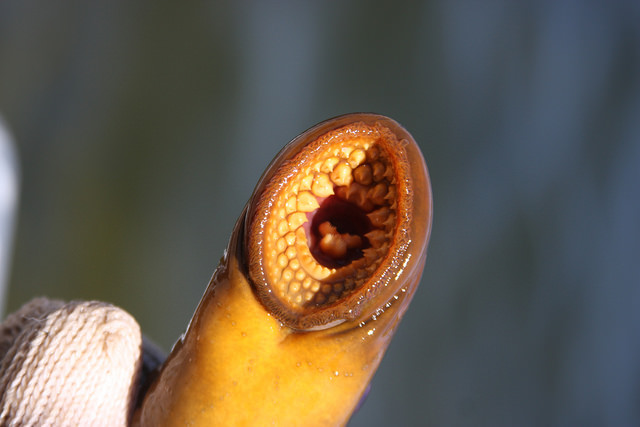By KEVIN DUFFY
Capital News Service
LANSING — For the first time, researchers have combined the smell of death with the lure of sex to better target a parasitic invader that has feasted on Great Lakes fish for decades.
Their target is the sea lamprey, an invasive species that uses its toothy sucker-like mouth to feast on Great Lakes trout, salmon, sturgeon, walleye and whitefish.

Sea lamprey from a trap site on the Cheboygan River in northern Michigan. Image: U.S. Fish and Wildlife Service
Before lamprey were managed, they cost the Great Lakes 110 million fish annually. The cost of control is about $20 million a year, saving about 100 million fish annually, said Marc Gaden of the Great Lakes Fishery Commission, the agency responsible for managing the sea lamprey.
Control today is primarily with a selective pesticide that’s dumped into rivers and streams to kill them.
Researchers know that lamprey are attracted by sex pheromones and repulsed by chemicals released by dead or dying lamprey. So last summer, in an experiment near Mackinaw City, they tried to repel the fish from one half of a stream with the chemical released by dead lamprey, and attract them with the pheromone to a trap in the other half.
The idea is to concentrate the invaders, making them easier to kill.
“The use of a repellant and attractant is a novel combination for use in a sea lamprey control program, something not typically used to control fish species,” said John Hume, the study’s lead author and a research associate at Michigan State University.
Until now, research was limited to lab settings, where controlled experiments revealed their extreme aversion to chemicals produced by decomposed lamprey when the same chemicals were dumped into a tank.
“This doesn’t occur naturally,” Hume said. “Decomposed lamprey are not dumped back in the water, but it’s conceivable that migrating lamprey grabbed by shoreline predators, like a heron or raccoon, will release the chemical compound intentionally or unintentionally.”
Downstream, the surviving lamprey can detect the chemical, avoiding it like a car would a series of traffic cones.
Dead, thawed lamprey larvae after a tough winter also signal this response although researchers remain unsure what the chemical compound is, where in the animal it’s produced and its biological function.
“Laboratory trials indicated that the push worked, but this was a chance to test it in the field in combination with a pull, the sex pheromone, which does seem to attract them in the wild,” Hume said.
Scientists know more about the sex pheromone, which mimics the scent of good spawning habitat. An MSU laboratory synthesized one part that attracts mature females.
They tested it with the repellant to see if the chemicals’ combined effect could push lamprey away from exclusion areas and pull them into a trap, he said.
The result: The repellant pushed lamprey across the river faster, but the partial sex pheromone’s effect on capture wasn’t measureable.
Hume said, “It’s not the silver bullet control boards get excited about, and that’s part of the problem with field experiments.”
Despite trapping an unusually high percent of lamprey, Hume says the partial sex pheromone works best on sexually mature animals, which weren’t used in the study.
Future research will focus on teasing out these relationships, determining their natural function and working with new barriers and traps.
“We’re working toward an all-tactics combined approach,” Hume said. “We have a barrier that blocks and redistributes them, we have the potential for many new improved traps and we know push- and pull-cues have shown success in the lab.”
Nearly 1,000 barriers, including dams, in the Great Lakes Basin are being incorporated into the control program, he said. They range from one to tens of feet above the surface of the water.
They control invasions that threaten local ecosystems and important commercial and recreational fisheries valued at $7 billion or more. But barriers also block native fish, including sturgeon.
Some migratory fish, including the Great Lakes invader, will move from a marine environment to freshwater before heading upstream for spawning. Barriers and dams obstruct their passage but also restrict movement of natives that safely coexist with other species.
“We’re facing competing priorities,” Wagner said. “We want to restrict the distribution and population sizes of invasive species but also open up our river networks to be used again.”
Chemical cues are also being investigated to help direct safe passage of native fish, but most fishways are designed for salmon and are hard for the native lamprey to navigate, said Mary Moser, a research fishery biologist with the National Oceanic and Atmospheric Administration.
Researchers hope to redesign the salmon-specific passes to support the movement of other native fish without removing barriers that have successfully trapped sea lamprey from moving upstream.
“We’re mapping their decision-making in the lab,” Wagner said. “And in the field, with the addition of selective fish passage, we’re learning how to use chemical cues to guide sea lamprey away from high-quality streams and into traps.”
Kevin Duffy writes for Great Lakes Echo.